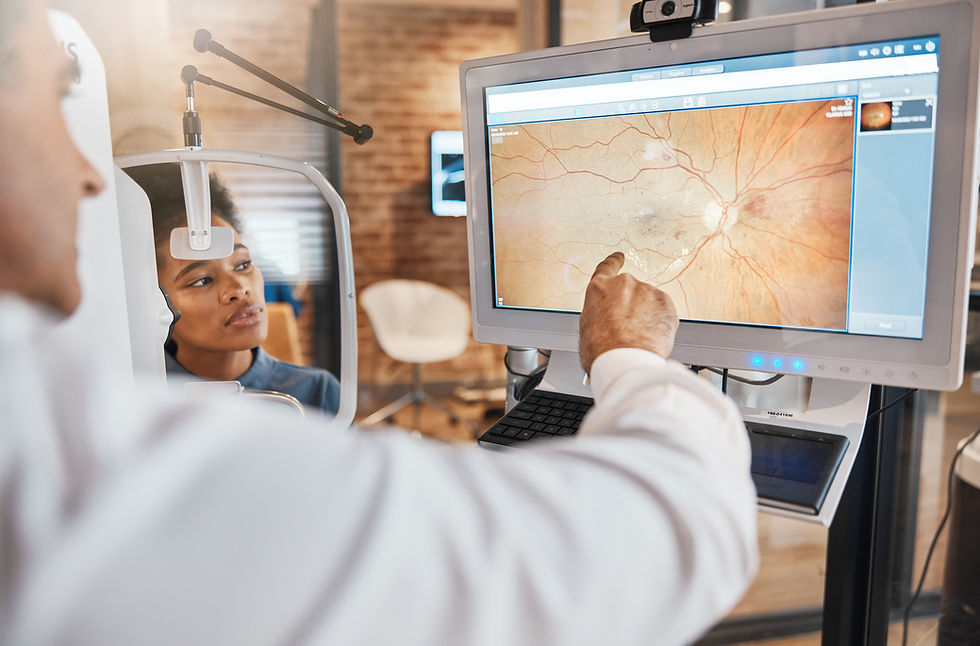The Eye as a Window to Your Health
- by Dr. Z Aleksic

- Oct 6, 2020
- 4 min read

It is the age of the smartphone, one when a new model of iPhone has been released every year. When we look at the trajectory of technology, it is quite astounding to look back at the older models which were only released a couple years prior. The camera, for instance, on the iPhone 6 versus a later model, the iPhone X, is astoundingly less clear, and this demonstrates the way in which imaging and camera clarity has advanced over a short period of time.
In the same continuum, eye screening, as implemented by our own screening centre, Oxia DM, employs fundus camera photographs, and the super-resolution and clarity of these images is what makes them even more illuminating than ever before. This means that medical screenings and scans have become increasingly smarter, just like the smartphone. Therefore, eye doctors are able to scan and screen for many more diseases simply with the snap of a photograph. This is the crucial link between doctor and photograph, which is why our team has been tirelessly working to set up screening centres such as Oxia DM. These centres are equipped with the iPhone SE of the medical world; the Fundus Camera.
There is the saying in the medical world that says, “the eyes are the window to a patient’s health” and this is something that has become more and more true as I have practiced as an eye doctor. In many ways, I have found that eye exams and screenings have been an invaluable tool for learning more about the overall health of that patient, and that screenings are useful not only for diseases pertaining to the eye, but also for other diseases.
This is because eye scans are able to detect silent diseases; ones that are dormant or have not yet been diagnosed. These include high blood pressure, diabetes, tuberculosis, rheumatoid arthritis, Herpes, HIV and elevated cholesterol. Besides the prevalent ocular condition/diseases, fundus photography can also be used to monitor individuals on anti-malarial therapy, by noting the changes in the fundus during standard screening. Fundus photography is also used in emergency cases including patients with constant headaches, diastolic pressure greater than or equal to 120mmHg and patients with sudden visual loss. In patients with headaches, the finding of swollen optic discs, or papilloedema, on fundus photography is a key sign, as this indicates raised intracranial pressure which could be due to hydrocephalus, benign intracranial hypertension, or brain tumor, amongst other conditions. Alternatively, cupped optic discs might indicate glaucoma. In arterial hypertension, hypertensive changes of the retina closely mimic those in the brain, and may predict strokes.
All of these conditions are detectable using fundus photography, yet many people do not have access to screening centres for these photographs to be taken. Oxia DM is our response to this problem, allowing people to have fundus photographs taken and their progression to be monitored. Oxia DM has been set up with a focus on diabetic retinopathy, but it can be used to detect many other of the aforementioned conditions. It has been set up in order to make this type of screening accessible, and to easily link the patient, the Fundus Camera Photograph, A.I. and the eye surgeon.
This is done in the following way:
1. Photographs
At the screening centre a camera technician will take photographs of the patient’s eyes using the fundus camera. The photographs are securely uploaded and stored. Once they are stored, they will be ready for analysis.
Our screening centres utilise a Fundus Camera; a super specialised camera equipped with high-resolution flash-photography. This allows for one of the only ways to observe arteries and veins in the body without being invasive. This is part of the screening process for diabetic retinopathy and is the most efficient way of managing eyesight problems for people with diabetes.
Fundus photography captures considerably larger areas of the fundus and has the advantage of photo documentation for future reference, as well as availing the image to be examined by a specialist at another location or time. In this way, your progression can be monitored. Artificial intelligence, may be added to this screening process at any time.
While you wait, our computer assisted algorithms will review the fundus images taken of your eyes. In this review, your image will be screened for diseases, such as diabetic retinopathy without the need for eye specialist visits or eye dilation.
2. Alert
Should the computer assisted system be alerted (output) to any conditions, then the patient will be referred to an ophthalmologist for further screening, diagnosis and treatment.
Within seconds a remotely located ophthalmologist will also review the photographs taken for more intensive scrutiny.
Once the photograph is taken at our clinic, our software may be used on the photograph to determine whether the patient should be referred to an eye specialist (ophthalmologist) for diabetic retinopathy treatment. The photographs are also stored on the Oxia DM software to allow a specialist to monitor changes and keep a history.
Detecting any abnormalities with the Fundus photographs can be used to follow up on the progress of the eye condition/disease such as diabetes, age-related macular-degeneration, glaucoma, and neoplasm of the choroid, retina or eyeball.
In patients with diabetes mellitus, regular fundus screening examinations (once every six months to one year) are important to screen for diabetic retinopathy as visual loss due to diabetes can be prevented by retinal medical treatments or/ and laser treatment if retinopathy is spotted early.


Take a look at the above images of fundus photographs. The left image is the latest technology, whereas the right image is from an older model of fundus camera. Simply compare the above images to see how much technology has changed, and how image clarity and screening could be the window to your health.
Learn more from https://www.oxia.org/diabetes-mellitus




Comments